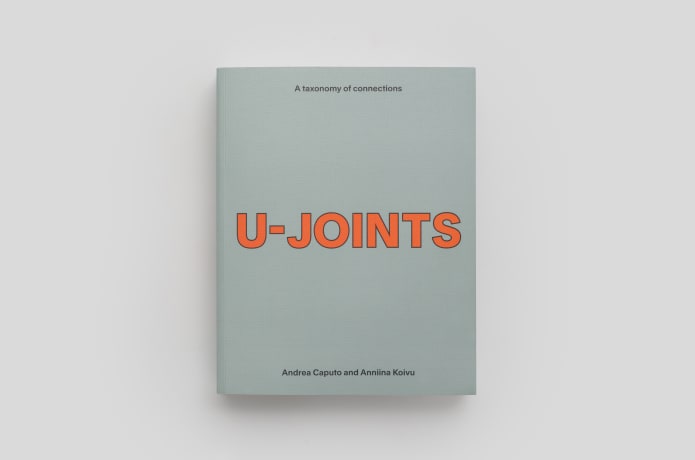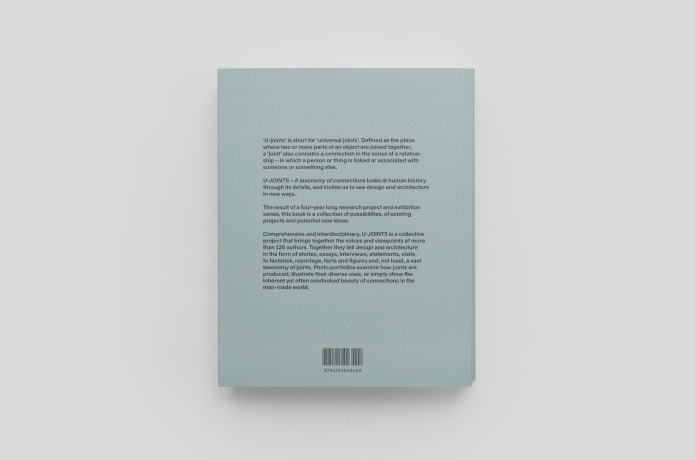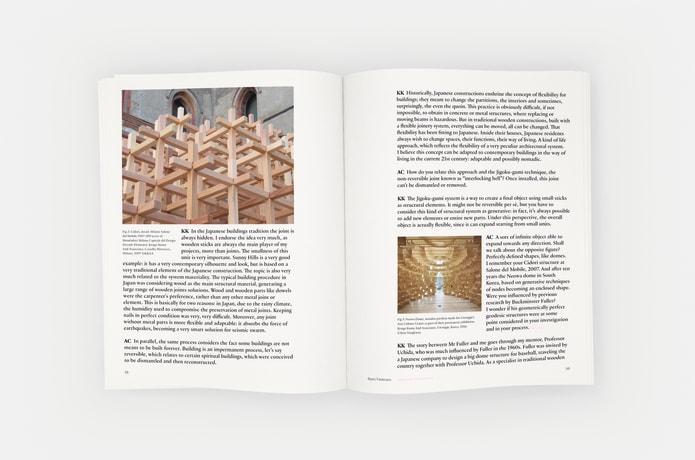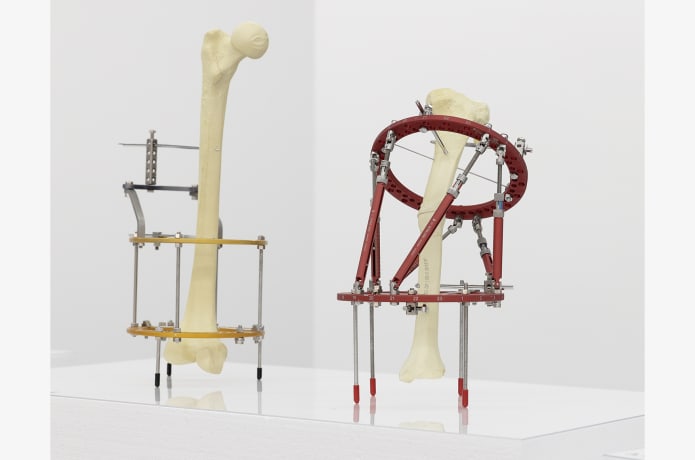U-JOINTS – A taxonomy of connections
U-JOINTS – A taxonomy of connections looks at human history through its details, and invites us to see design and architecture in new ways.
The result of a four-year long research project and exhibition series, this book is a collection of possibilities, of existing projects and potential new ideas.
Comprehensive and interdisciplinary, U-JOINTS is a collective project that brings together the voices and viewpoints of more than 120 authors. Together they “tell” design and architecture in the form of stories, essays, interviews, statements, visits to factories, reportage, facts and figures and, not least, a vast taxonomy of joints. Photo portfolios examine how joints are produced, illustrate their diverse uses, or simply show the inherent yet often overlooked beauty of connections in the man-made world.
Each chapter traces the macrocosm of joinery. Together, they create a vast overview of the most common joints as well as insight into joinery’s unique solutions, historical and contemporary. Little known surprises and forgotten connecting methods abound.
Furthermore, the book features 80 essays and interviews, as well as 120 anecdotes. These share the often-unknown stories of joints, from how they were invented to their many inventive applications. The book also includes more than 1000 images, 240 illustrations and numerous patents. 15 new photographic works by young and upcoming photographers reframe the overlooked details for readers to discover.
![]()
U-JOINTS – A taxonomy of connections, front cover. ©Delfino Sisto Legnani
![]()
U-JOINTS – A taxonomy of connections, back cover. ©Delfino Sisto Legnani
![]() A Sample spread of the Taxonomy section, featuring more than 1300 joints and connections. It includes most common joints as well as unique solutions from history. ©Delfino Sisto Legnani
A Sample spread of the Taxonomy section, featuring more than 1300 joints and connections. It includes most common joints as well as unique solutions from history. ©Delfino Sisto Legnani
![]()
Photographers were commissioned to shed light on the often hidden details of an object. Reproduction ©Delfino Sisto Legnani
![]()
A new generation of photographers produced more than 15 portfolios of joints and connections. Reproduction ©Delfino Sisto Legnani
![]()
More than 50 authors contributed essays and interviews with international architects, designers, artists, inventors, scholars, makers and users of well-designed products and architectures.
Eleonora Castellarin is the mastermind behind the extensive Taxonomy.
Graphic Thought Facility created the straightforward and simple layout that presents an immensity of information effortlessly.
Contributors, subjects and authors include more than 120 authors, researchers, designers, architects, artists, photographers and illustrators: Johanna Agerman Ross, Florian Amoser, Andrea Anner, Ron Arad, Ines Ariza, Amy Auscherman, Kate Bachman, Mattia Balsamini, Margherita Banchi, Olivo Barbieri, Anna Bates, Luca Becchetti, Martin Bereuter, Robin Bervini, Elizabeth Bisley, Philippe Block, Jörg Boner, Erwan Bouroullec, Ronan Bouroullec, Thibault Brevet, Barbara Brondi, Franco Bulian, Gabriela Burkhalter, Carlo Carbone, Marco Casino, Eleonora Castellarin, Michel Charlot, Pierre Charpin, Andrew Clancy, Johann Clopath, Brendan Cormier, Andrea Corsi, Matthieu Cortat, Marco Costantini, Douglas Coupland, Giuliana Crocco, Nicolai de Gier, Marco De Michelis, Thomas Demand, Benjamin Dillenburger, Delphine Drouin-Prouvé, Félix Escrig-Pallarés, Didier F Faustino, Ramak Fazel, Margherita Ferrari, Luigi Fiano, Lia Forslund, Vincent Fournier, Hiroshi Fujiwara, Fabrizio Gallanti, Lukas Gansterer, Ilaria Giannetti, Raúl González-Bravo, Fabio Gramazio, Susanne Graner, Stefano Graziani, Konstantin Grcic, Maxime Guyon, Sebastian Hackenschmidt, Dirk Hebel, Sam Hecht, Christina Högner, Yngve Holen, Clare Hunter, Dylan Iwakuni, Hella Jongerius, Jane Joyce, Hettie Judah, Eliyahu Keller, Kevin Kelly, Emily King, Ruby Kitching, Matthias Kohler, Jolanthe Kugler, Kengo Kuma, Wataru Kumano, Evey Kwong, Markus Lahteenmäki, Tiffany Lambert, Andreas Larsson, Anssi Lassila, Gabriele Lelli, Miles Lewis, Thomas Lommée, Cecilie Manz, Enzo Mari, Michael Marriott, Allegra Martin, Sally McGrane, Joanne McNeil, Alberto Meda, Renee Merckx, Nicholas W Moore, Leonardo Mosso, Jonathan Olivares, Manuel Orazi, Federico Parolotto, Des Pawson, Eugenio Perazza, Tom F Peters, Philippe Petit, Marta Pezzoli, Francesca Picchi, Matteo Pirola, Nicolas Polli, Mariana Popescu, Irene Posch, Bertjan Pot, Piercarlo Quecchia, Marco Rainò, Julie Richoz, Nadja Rottner, Chiara Francesca Ruggiero, Paolo Rui, Tom Sachs, Simone Sandahl, Christoph Schindler, Burkhard Schmitz, Alessandro Simonetti, Delfino Sisto Legnani, Sina Sohrab, Peter Steinhauer, Bruce Sterling, Oli Stratford, Deyan Sudjic, Christian Sumi, Fabio Targa, Skylar Tibbits, Joanna van der Zanden, Justinas Vilutis, Kari Virtanen, Yves Weinand, Philippe Weisbecker, Mark Whitby, Richard Wiborg, Alastair Philip Wiper, Peter Zumthor.
Each chapter constitutes a proposal: by looking at particular details, we can help you understand the constructed world a little better. As a result, this publication is many things: a manual in a workshop, an encyclopedic reference guide for scholars and design enthusiasts, as well as an indispensable resource for students of architecture and design.
U-JOINTS project
A joint – the union of two or more parts – is a fundamental element in almost any designed object, be it a famous bridge, the coffee maker in your kitchen, or a revolving office chair.
The joint comes in every possible size and material: nanoscale or the size of a room; plastic, steel, carbon fibre, wood or wool. A joint might be ingeniously engineered or the result of garage tinkering. Designers, architects and engineers alike appropriate standard connectors; they assemble and personalise them. Sometimes, they invent new joinery from scratch. Truly multivalent, the joint is the kind of detail that holds the world together.
But because a joint is often invisible, hidden elegantly within an object, it can be overlooked.
U-JOINTS sheds light on these hidden details in an in-depth survey of joints.
![]()
U-JOINTS – Equations of a universal lifestyle exhibition, Salone del Mobile, Milano, 2018 ©Delfino Sisto Legnani
![]()
U-JOINTS – Equations of a universal lifestyle exhibition, Salone del Mobile, Milano, 2018 ©Delfino Sisto Legnani
U-JOINTS background
The U-JOINTS research project was initiated in 2018 with an exhibition. Called U-JOINTS – Equations of universal life, it took shape as an eclectic introduction to the topic of connections. Curators Andrea Caputo and Anniina Koivu broke joints open, organised them by material and production processes, reassembled them into prototypes, and used them in real-world applications. For eight days, U-Joints featured 919 exhibits by 50 international designers and industry professionals. On show was everything from the most common joints to design’s most innovative ones, as well as those that have had the greatest influence on contemporary design and architecture.
Encouraged by the exhibition’s success and the remarkable attention and endorsement it garnered, the team launched an extensive research challenge: a comprehensive review of the world’s joints and how they hold things together.
Employing an inclusive and collective approach from the very beginning, the research is shared with the public through a series of exhibitions in which contemporary designers, researchers, institutions and critics are invited to share their work with joinery.
Each show reads like the chapter of a book.
In 2019, A taxonomy of nails, screws, rivets, bolts and nuts looked at basic fasteners and was held at Galerie l’elac of ECAL/University of Art and Design Lausanne in Switzerland.
![]()
U-JOINTS – A taxonomy of nails, screws, rivets, bolts and nuts exhibition, ECAL, Lausanne 2019 ©Calypso Mahieu
![]()
U-JOINTS – A taxonomy of nails, screws, rivets, bolts and nuts exhibition, ECAL, Lausanne 2019 ©Calypso Mahieu
Adhesives and Fusions was hosted in 2022 at the Gewerbemuseum Winterthur. The exhibition provided an informative and fascinating insight into the versatile strength of adhesives and bonding agents, both traditional and newly developed, which are used in areas ranging from object design and architecture to sport, the food industry and medicine. The show scrutinises not only adhesives but also fusions. The latter term covers a wide variety of traditional welding techniques, right through to sophisticated methods with intriguing names such as high frequency welding, plasma brazing, stereolithography and 4D printing.
![]()
U-JOINTS – Adhesives and Fusions, Gewerbemuseum Winterthur, 2022 ©Piercarlo Quecchia, DSL Studio
![]()
U-JOINTS – Adhesives and Fusions, Gewerbemuseum Winterthur, 2022 ©Piercarlo Quecchia, DSL Studio
![]()
U-JOINTS – Adhesives and Fusions, Gewerbemuseum Winterthur, 2022 ©Piercarlo Quecchia, DSL Studio
Currently, U-JOINTS – Knots & Knits is on show at Fishers Village Biennale. Open until September 2022 U-JOINTS – Knots & Knits unravels the joints of textiles, fabrics, meshes, membranes and ropework. Whether used in rigging, for lifting heavy objects, wrapping a lunch box or closing a gift, securing a funambulist’s highwire, to keep a climber from falling off a wall or creating adventurous playgrounds for children, knots are considered the oldest and most basic techniques of joinery. The exhibition examines all this and more.
![]()
U-JOINTS – Knots & Knits, Fiskars Village Biennale, ongoing exhibition @Aleksi Poutanen
![]()
U-JOINTS – Knots & Knits, Fiskars Village Biennale, ongoing exhibition @Aleksi Poutanen
Further exhibitions are being planned.
U-JOINTS press and comments
Paola Antonelli, senior curator, MoMA: "U-Joints has been my favorite stop in Design Week. Curated by Andrea Caputo and Anniina Koivu, it is an outstanding exhibition on joints and connections. It features an obsessive taxonomy and a thorough timeline. Unadulterated curatorial delight!”
Alice Rawsthorn, design expert: “You may never confuse a clamp with a coupling, or a dovetail with a rivet again.”
Alice Stori, design curator: “If you have to see one thing this Salone make it the U-Joints exhibition curated by Andrea Caputo and Anniina Koivu! Every designer and design student should bring their sketch book and get down to basics.”
Zoë Ryan, director of the Institute of Contemporary Art, University of Pennsylvania: “U-Joints […] examines a multitude of simply that – ways to join things together – through 50 designers’ experiments, prototypes and products. Great show.”
Disegno magazine: “Curators Andrea Caputo and Anniina Koivu are to be applauded. On paper, their pitch for U-Joins sounds dry and inaccessible: an exhibition examining a history of the joint and other connecting technologies within design. The results, however, are anything but. U-Joints is engrossing and animated, while nonetheless not shirking the inherent technicality and geekery of its subject matter; it manages the delicate balance of being both a real designer’s design exhibition, while also remaining of interest to a general audience.”
Modern Design Review: “U-Joints is not only one of the best shows of this year’s Salone, it’s one of the best shows to be presented at the Salone for a long time.”
Publication specs
Graphic Design: Graphic Thought Facility
Format: 21x26.9 cm (8,25x10,59 in)
Volume: 943 pages
Language: English
Editors
Andrea Caputo is an architect and researcher living in Milan. He combines his professional practise with ongoing research in the architectural and urban planning fields, and has published numerous editorial projects and articles. In 2011, Andrea opened his award-winning architecture studio in Milan and three years later, in 2017, he opened another in Shanghai. His work is recognised for its unexpected solutions, often juxtaposing different materials, which draw attention to the smallest of architectural details. The studio works internationally, developing complex projects on all scales, in collaboration with a qualified network of specialist consultants. His first investigation into urban culture’s aesthetic and social influences was published as All City Writers (Critique Livre, 2009) and soon became a sought-after reference work for street culture. From 2018-19, he edited Domus magazine's "Studio Visit" column, which explored contemporary architecture studios’ practices. Currently, Andrea’s studio is engaged on behalf of the Vastushilpa Foundation of Ahmedabab to conduct a vast survey on the architecture of Balkrishna Doshi, Pritzker Prize 2018. www.andreacaputo.com
Anniina Koivu is a design writer, curator, consultant and teacher. Based in Milan and Lausanne, she works across a number of fields, from curation to art direction, product development, and editorial and research projects. Her clients include Kvadrat, Iittala and the Shorefast Foundation, for whom she is design director of the Smaller House Furniture collection of Fogo Island Workshops. Her latest publication Vico Magistretti: Stories of Objects (ECAL/Triest, 2020) is the result of an investigation into the little-considered moment in the lifespan of design products when production stops. She wrote the comprehensive monograph on Ronan and Erwan Bouroullec, Works (Phaidon, 2011) and has edited and contributed to many other design publications. She is co-curator of Plastic – Remaking Our World (Vitra Design Museum, 2022). She is Head of Master Theory at ECAL/University of Art and Design Lausanne. www.anniinakoivu.com
If you want to receive the U-J book before X-mas please write directly us by e-mail.
Contacts
email: info@u-joints.com
instagram: www.instagram.com/u_joints
website: www.u-joints.com



 A Sample spread of the Taxonomy section, featuring more than 1300 joints and connections. It includes most common joints as well as unique solutions from history. ©Delfino Sisto Legnani
A Sample spread of the Taxonomy section, featuring more than 1300 joints and connections. It includes most common joints as well as unique solutions from history. ©Delfino Sisto Legnani










